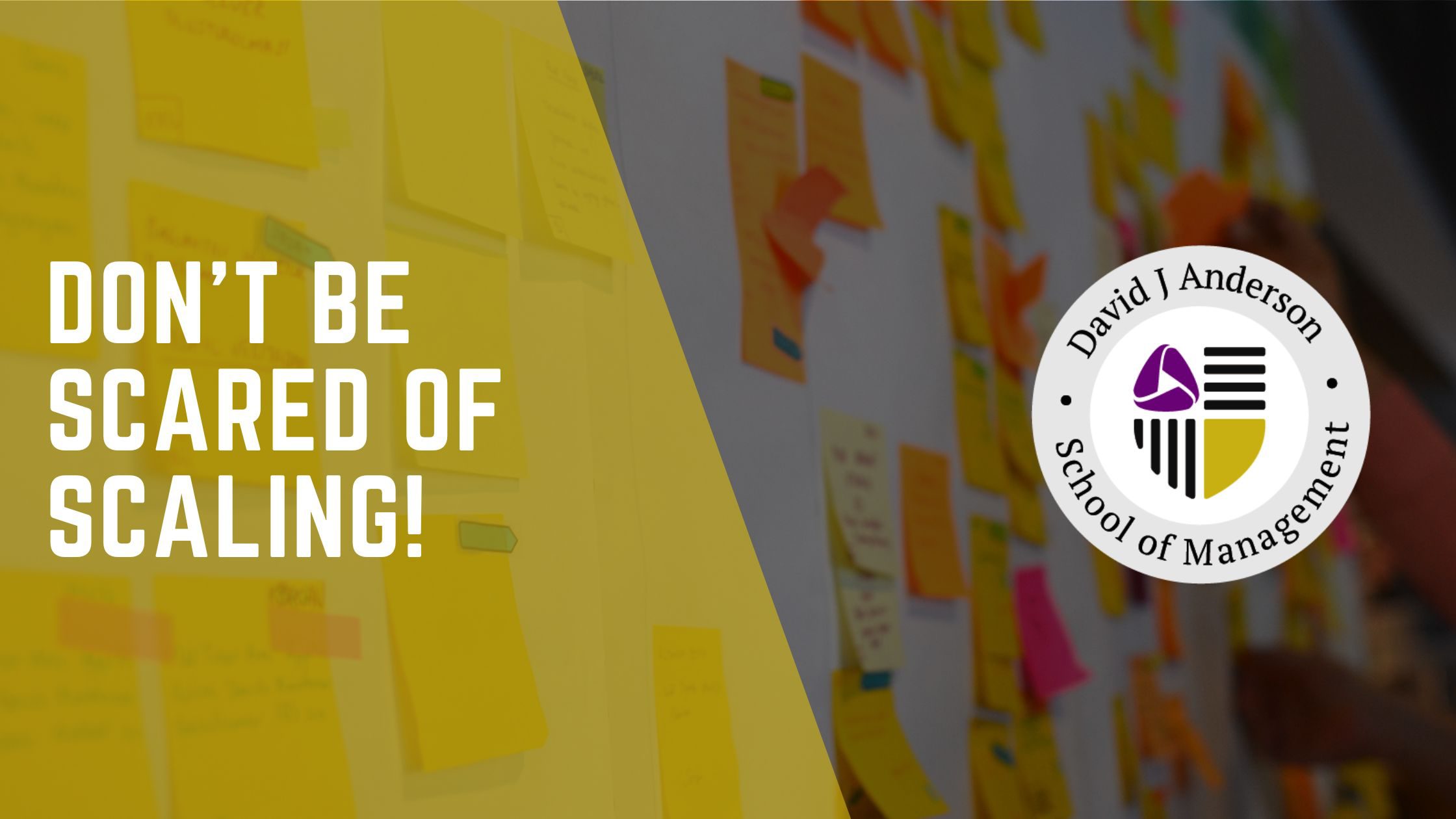Kanban's Service Delivery Principles
This is the second post outlining the 6 principles of The Kanban Method. This one explores the 3 Service Delivery Principles. While service delivery has been core to Kanban since 2004, the emphasis on it in our literature is recent and this text is new and still emergent. This is another extract from the forthcoming book, “Essential Kanban: The Guide” co-authored with Andy Carmichael.
Kanban’s Service Delivery Principles
The Kanban Method is rooted in the premise that we can learn to cope with abundant complexity of the modern workplace by thinking of it as an ecosystem of interdependent services and learning to manage and organize in a service-oriented fashion. This provides us with a massive simplification that we can think of an organization as a network of services where each node in the network represents a service, even if that service spans across functions within the organizational hierarchy. This enables us to manage the business allowing each service (each node in the network) to evolve independently through evolutionary change driven by fitness criteria metrics that model the desired level of service the customers of each service need in order to meet their own needs. Hence, external customer needs and expectations can cascade through the corporate ecosystem of interdependent services and large scale, holistic improvements can emerge from localized improvements driven at level of each service.
Fundamentally, Kanban is an approach to improving service delivery. It was first introduced (in 2004) within Microsoft’s IT department as an approach to improved service delivery. The change management benefits were not realized or appreciated until 2007 with the implementation at Bill Gates’ photography archive and intellectual property rights management business, Corbis. A choice was made in 2009, to emphasize evolutionary change as the unique aspect of Kanban. In more recent years, the original service delivery benefits have come back into vogue.
Service Delivery Principles
Your organization is an ecosystem of interdependent services. Kanban acknowledges this with three service delivery principles, applicable not just to one service but to the whole network:
- Focus on the customer
Understand and focus on your customers’ needs and expectations - Manage the work; let people self-organize around it
- Evolve policies to improve customer and business outcomes
Policies determine the characteristics of your service delivery system; evolve policies so that customer satisfaction and business outcomes improve
Let’s look at each principle in more detail.
Focus on the customer
Why do we want to improve? What is it we are trying to improve? And at a higher level, recognizing that our service is just one amongst an interconnected ecosystem, what changes can we make that will enable survivability – robustness, resilience, and adaptability?
Ultimately, it is our customers that decide whether our service is “fit for purpose” and it is their dissatisfaction that should drive our need for improvement.
Even when we are a monopoly (internal) supplier, if we share the value of customer focus, there will be motivation for change – those changes should, equally, be customer focused. Focusing on the customer means we need to understand customer needs. We need to segment our customer base, based on their needs and expectations. We need to view our customers based on the criteria they use to evaluate whether they are satisfied with our service and whether they would recommend us or speak highly of us. These criteria are known as Fitness Criteria and we should adopt them as the metrics which drive our improvement initiative.
We need a clear understanding of who our customers are, what they ask us for, and what their expectations are in terms of service levels. By taking a customer focus we will design a kanban system with suitable capacity, capacity allocation and classes of service that can meet their needs – or least the needs we are prepared to fulfill within our economic constraints and risk tolerance.
Manage the work; let people self-organize around it
Throughout the 20th Century, the management of professional services where the goods are intangible has focused on the people and the time those people have to perform work. In other words, management has focused on what it can see – the people – and what it can measure – the time those people have available. Unlike tangible goods businesses, there has been little to no attempt to focus on and manage inventory levels and the “movement” of unfinished work through the organization. The Kanban Method posits that this has been a fundamental mistake!
By visualizing invisible work – intangible goods – we enable an ability to manage more like we do with physical environments. Counting how many user stories are in-progress in a software development team can be established as a fact. Counting how many ad campaigns are in development at an advertising agency can be established as a fact. Counting how many graphic design jobs are in progress in a visual design department can be established as a fact. While trying to guess how long any one of these tasks will take and how much “capacity” individuals have, based on how many hours they are available to work, has been pure guess work. The reason for this is that the duration of such creative knowledge work tasks is a non-deterministic problem. We’ve been using an inappropriate method for managing modern work producing intangible goods.
By visualizing the invisible, we enable an ability to manage with facts rather than guesses and speculation. It appears to work more effectively!
The customer asked for something, even though that something is an intangible good – think of it like something physical like ordering an omelet from the short order chef at breakfast, or a cup of coffee in a self-service face such as Starbucks. Managers in such businesses are not trying to estimate how long the item will take, allocate a worker, and calculate how many such tasks can be performed in a given time period. Instead, they manage the work, the workers pick up the job requests, produce what was requested, deliver it to the customer and move on to the next job. In a physical environment they have it easy – there are physical constraints that create obvious work-in-progress limits and queues are deterministic. For knowledge work we need to create virtual limits to work-in-progress and learn to cope with non-deterministic buffers where we pick items based on suitability of matching work to a worker’s skills and experience, or based on the required class of service of items waiting. Once we’ve learned to cope with these differences, managing work in order to focus on the customer, becomes second nature. To do it, we need to unlearn a behavior that we should never have learned in the first place – managing people and time. It’s better to manage work while visualizing the goals for workers – let them understand the customer, their needs, their expectations, the risks they are managing, what they’ve asked for and why they need it. Kanban boards enable us to visualize us this and enable a new way of managing. As a result, customer service improves because the whole system is designed around the customer and their requests – the intangible goods we must create.
Evolve policies to improve customer and business outcomes
Processes can be reduced to the concept that they are simply a set of policies which lay out how work should be done, who should do what, and in which order or sequence. They define how decisions should be frame and made. They provide governance rules and audit check points. When you encounter a sign by the mirror, in the restroom of your local café stating “Employees must wash their hands.” This is a policy. It is a policy which is also a regulatory requirement. It trades off hygiene, health and safety, against how much time the employees spend in the restroom and how quickly they can return to work. Most policies represent decisions which trade off one aspect of risk against another. “all code must have unit tests” trades off functional quality, and future maintainability against initial development time. The fourth practice of the Kanban Method asks us to “make policies explicit.” Instead of viewing our processes as a sequence of activities, workflow, roles and responsibilities, we want you to view your existing processes as sets of policies and those policies should be defined explicitly. This doesn’t mean you need a large catalog of policies. Some policies can be encoded into Kanban Board designs while others can be encoded into meeting formats.
Making policies explicit makes them discussable. It opens them up for review by a wide audience and it usually makes the reason for the policy self-evident. The risks the policy trades are understood. As a result, the policy can be challenged and changed if risks change. The appropriateness of the policy and the outcome it produces can be challenged – are we too risk averse? Are we taking too much risk?
Classes of service are sets of policies. A class of service is a set of policies that describe how an item of work should be treated. Classes of service should be directly aligned to customer expectations and the fitness criteria with which the customer evaluates our performance. Thinking in policies enables us to serve the customer better.
Thinking in policies can help us align with the change management principles. By moving away from viewing a process as a methodology consisting of defined workflow, roles and responsibilities, and thinking of it as a set of policies for deciding how work is treated, we focus on the work, and not the workers, and we are less likely to invoke identity related resistance to changes even when changing a policy, changes the responsibilities or accountability of an individual.
Related post: Kanban’s Change Management Principles




